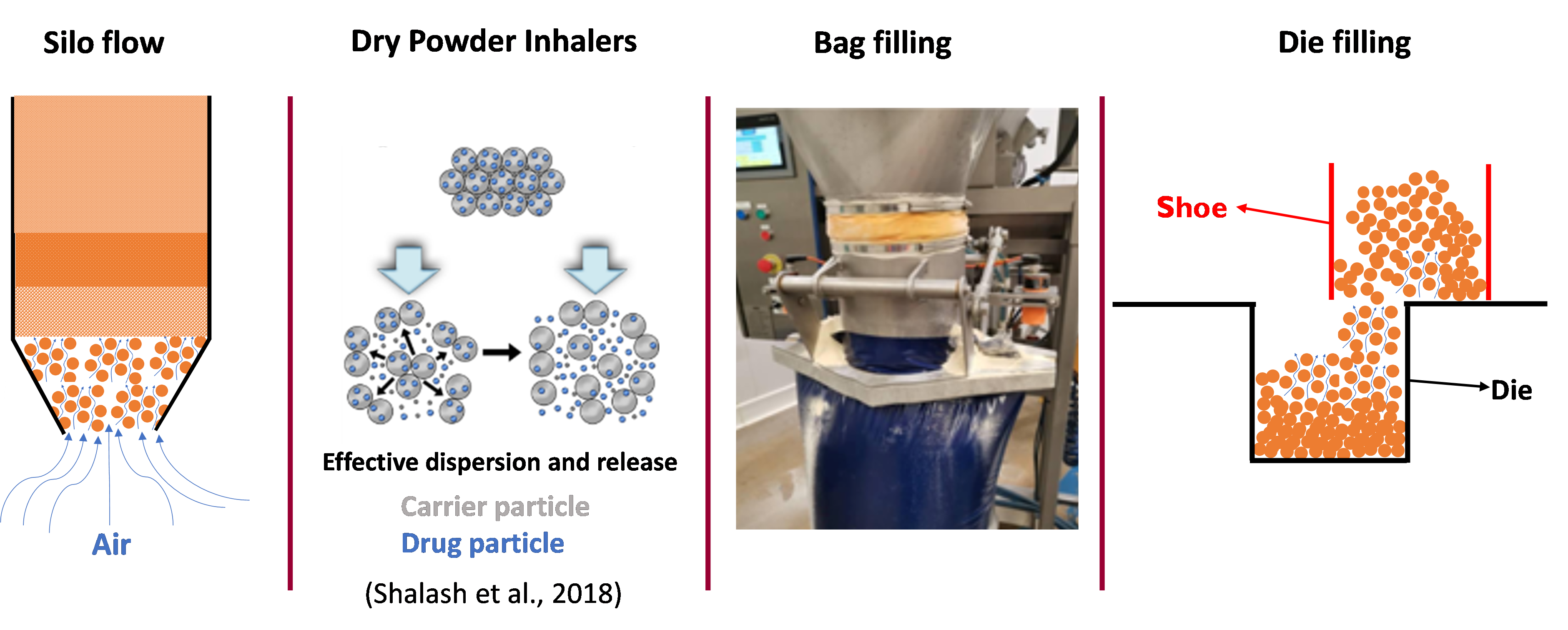Blog
Powder Permeability Measurements at Low Consolidation Conditions
In this blog article, we explain what powder permeability is and its importance with the GranuPack Permeability.
What is the powder permeability and why is it important?
Powders are widely used in many industrial processes, such as pharmaceutical, additive manufacturing, food, cosmetics, metallurgic, and many others. Powder behavior during the process is affected by various properties such as particle size and shape, particle size distribution, cohesive forces between the particles (Van der Waals, electrostatic, capillary), interlocking, and friction between the particles. Strongly dependent on these properties is the permeability, which is the capacity of a fluid, usually air, to pass through a powder bed. Powder permeability is an important factor for numerous industrial processes. In pharmaceutical tablet manufacturing, the filling of the die (Figure 1) is directly influenced by the permeability as the air determines the powder flowability during the displacement of the powder within the die, as well as the capacity of the powder to pack in the die. The easier the capacity of air togo out of the powder, the more efficient the powder packing in the die and consequently the quality of the final tablet in terms of weight uniformity, packing fraction, tensile strength, disintegration, and dissolution behavior of the tablet (Van Snick et al., 2017).
Another example is the discharge of silo (Figure 1) where the air must pass through the particles to allow the powder to easily flow out of the silo (Hsiau et al., 2012). In the bag filling process (Figure 1), the larger the permeability the larger the powder densification, and the larger the filling capacity (Murfitt & Bransby, 1980).
The previous examples show how permeability can affect the process efficiency. Therefore, it is very important to measure it to predict the powder behavior in the process. Usually, the permeability is measured at high consolidation stresses but, in many processes, the powder experiences low consolidation conditions. Since the permeability is directly influenced by external stresses, there is a need to measure the permeability at packing conditions that are similar to those experienced by the powder during the process. By doing so, it is possible to properly predict the powder behavior in the process.

Figure 1: Examples of processes affected by the powder permeability
How to measure permeability at low consolidation conditions and various packing fractions?
Granutools has developed a methodology to measure powder permeability at low consolidation stresses. It combines the capacity of the GranuPack to control the densification of the powder through taps and the possibility to measure the permeability at various packing fractions. A new measurement cell has been developed to this aim. The cell is composed of a porous frit which allows the air to go through the powder bed and theairflow rate can be precisely controlled.
Looking at the evolution of permeability with the packing fraction is useful to understand how the process could affect the powder permeability, and hence the powder behavior. Moreover, knowing the packing fraction reached by the powders in the process, it is possible to measure the permeability in the same packing conditions of the process and make a comparison between powders. For example, it is possible to predict whether a powder is more permeable than another in the same process conditions.
By using the GranuPack with the permeability cell, it is also possible to relate the permeability to the flowability, measured in terms of the Hausner ratio, to understand the effect of flowability on the variation of permeability with the packing fraction.
Conclusion: GranuPack and the permeability cell can be used to predict the powder behavior in industrial processes or applications
The proposed methodology opens up new possibilities for investigating the powder behavior in industrial processes or applications. In fact, by evaluating powder permeability at packing conditions similar to the process, it could be possible to understand process inefficiencies and product issues. In addition, it could be possible to choose new powder formulations and/or decide on suitable powder pre-conditioning procedures, aimed at increasing the permeability, preventing process issues, enhancing process efficiency, and improving product quality.
To have more information about the GranuPack Permeability, register now to the Product launch that will take place on the 21st of November 2023.
Register for the product launch of the GranuPack Permeability
References
- Hsiau, S., Liao, C., & Lee, J. H. (2012). The discharge of fine silica sand in a silo under different ambient air pressures. Physics of Fluids, 24(4). https://pubs.aip.org/aip/pof/article/24/4/043301/25757
- Murfitt, P. G., & Bransby, P. L. (1980). Deaeration of powders in hoppers. Powder Technology, 27(2), 149–162. https://doi.org/10.1016/0032-5910(80)85017-0
- Van Snick, B., Holman, J., Cunningham, C., Kumar, A., Vercruysse, J., De Beer, T., Remon, J. P., & Vervaet, C. (2017). Continuous direct compression as manufacturing platform for sustained release tablets. International Journal of Pharmaceutics, 519(1–2), 390–407. https://doi.org/10.1016/j.ijpharm.2017.01.010
- Shalash, A. O., Khalafallah, N. M., Molokhia, A. M., & Elsayed, M. M. A. (2018). The Relationship Between the Permeability and the Performance of Carrier-Based Dry Powder Inhalation Mixtures: New Insights and Practical Guidance. AAPS PharmSciTech, 19(2), 912–922. https://doi.org/10.1208/S12249-017-0898-7

.jpg)